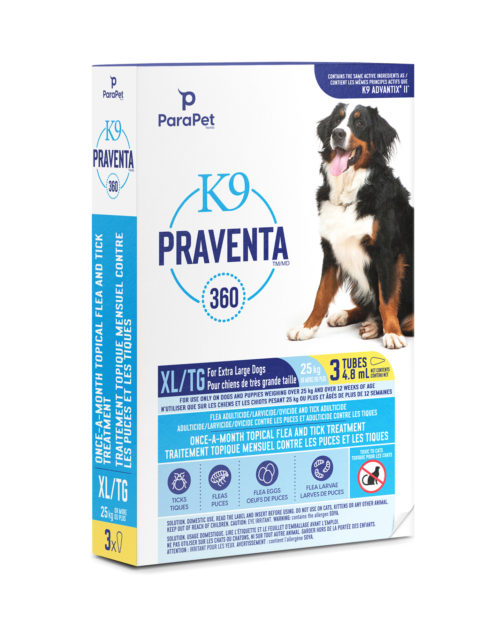Halloween can be a fun time for young and old alike, but it can also be a stressful time for pets. Having a steady stream of trick-or-treaters ringing the doorbell or knocking at your door can be disruptive and upsetting to your dog’s normal routine. Here’s some handy tips to help keep your pet happy, safe, and stress-free this Halloween:
LIONS AND TIGERS AND BEARS…OH MY!
With the flurry of activity that comes with the sheer number of strangely dressed visitors constantly arriving at your door, even the best-behaved dog can become skittish or overwhelmed. A dog’s natural instinct is to protect their home or to alert you that a stranger has arrived, so having a bunch of trick-or-treaters continually knocking on the door or ringing the bell can cause your dog a lot of anxiety and stress.
Signs of stress can include:
- Panting
- Hiding
- Excessive barking
- Pacing
- Going to the bathroom in the house
Before the trick or treating starts, consider putting your dog in their crate, out of sight of the front door, or in a quiet, secure room where it will be safe and out of the way from all the activities. Also, to help minimize the noise and disruption, consider sitting outside to hand out the candy.
DECORATION DANGERS
Who doesn’t love Halloween decorations? But did you know that they can pose a health and safety threat to your dog?
Glow sticks, while helpful in safely lighting the way for trick-or-treaters, can be mistaken for a chew toy by your dog. Smaller decorations can be a choking hazard and popular decorations such as pumpkins and decorative corn, while considered relatively non-toxic, can still cause stomach upsets in pets that nibble on them.
Obvious dangers, such as lit candles (on their own or inside of jack-o-lanterns), can be easily knocked over, burning your pet. And while electric and battery-powered decorations may be considered safer, they can still present a health risk to your dog should they chew on the electrical cord or accidently swallow a battery.
For a pet-friendly Halloween, ensure that all Halloween décor is kept safely out of your pet’s reach.
LOCK UP THE CANDY
With a dog’s acute sense of smell and inquisitive nature, it’s almost guaranteed that your pet will be able to sniff out even the most well-hidden candy stash.
Halloween treats may be delicious to humans, but they are unsafe for pets. Chocolate can be deadly to dogs, many sugar-free gums and candies contain xylitol (artificial sweetener) which is dangerous for pets to ingest, hard candies can pose a choking hazard, and candy wrappers can lodge in your dog’s throat or digestive tract causing an intestinal blockage that can require surgery to remove.

To ensure your pet’s health and safety, be sure to keep your candy locked up or else store it up high on a shelf that’s safely out of your pet’s reach.
DON’T LEAVE YOUR PETS OUTSIDE
Keep your pets indoors on Halloween night. With more people out on the streets than usual, you don’t want to run the risk that they’ll get spooked by all the commotion and run away out of fear and confusion — or worse, leave them vulnerable to cruel pranksters that might harm them intentionally.
WHO LET THE DOG OUT?
Opening the front door repeatedly for trick-or-treaters makes it hard to keep an eye on your dog all the time. So, the potential for your pet to slip outside and disappear into the night is high. Should your dog escape and become lost, having the proper and up-to-date identification will go a long way to increasing the chance of your pet being found and returned safely.
Make sure your dog is wearing their collar and current ID tags. If your dog is microchipped, ensure your contact information is correct in the microchip company’s database. If your dog is not microchipped, you may want to consider it, as it offers a more permanent identification solution should the collar or tag fall off.
Tip: Use Halloween as a yearly reminder to double-check your address and contact information on your dog’s tag and with the company that supports your pet’s microchip.
PET COSTUMES…DOS AND DON’TS
Who can resist a cute dog in an adorable Halloween costume? But while some dogs don’t mind playing dress-up, others might. So, if you’re planning on dressing up your dog, consider the following:
- Before choosing a costume for your dog, consider their personality and what type of costume they might tolerate and for how long.
- Choose a comfortable costume that fits properly, doesn’t restrict movement, and doesn’t hinder your dog’s ability to breathe, see, and hear.
- Make sure the costume doesn’t have any small parts, buttons or decorations that can come off easily or that your pet can chew off and swallow.
- Have your dog try on the costume prior to Halloween night. It’s a good idea to introduce your pet to the costume early and go slowly, putting it on them for short periods of time so they can get used to it. Make it a positive experience by offering your dog lots of praise or treats.
- Never leave your costumed dog unattended. Always supervise your pet when they’re wearing their costume, so that in case of an emergency you can immediately step in.
If at anytime your dog shows signs of stress or discomfort while wearing the costume (such as folded down ears, eyes rolling back or looking sideways, a tucked tail or hunching over, pacing, hiding, or refusing to move) take it off. No matter how cute your dog may look, it’s not worth causing your pet stress and anxiety over.




